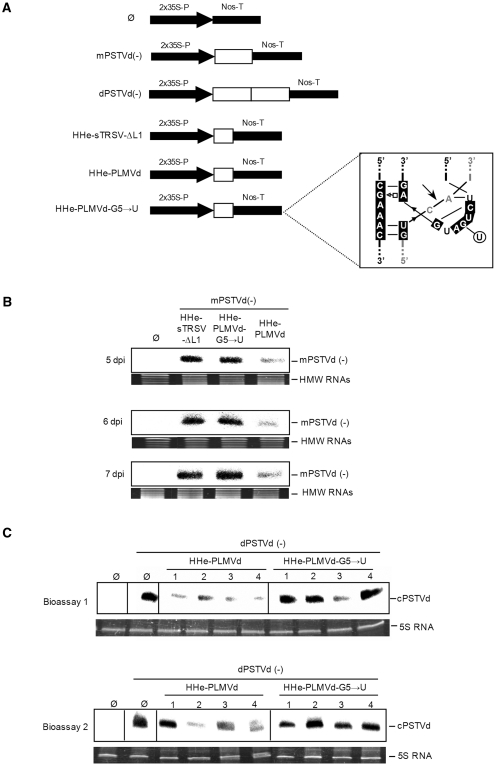Figure 7.
In vivo effects on PSTVd RNAs of three extended hammerheads co-agroinfiltrated in N. benthamiana. (A) Schematic diagrams of the constructs with the expression cassettes (boxed and with white background) between a double copy of the 35S promoter and the Nos-terminator: empty vector (Ø), monomeric PSTVd (–) RNA [mPSTVd(–)], dimeric PSTVd (–) RNA [dPSTVd(–)], the minimal hammerhead HHe-sTRSV-ΔL1, and the hammerheads HHe-PLMVd and HHe-PLMVd-G5→U (with the mutation affecting the catalytic center indicated within the inset). (B) Analysis by denaturing PAGE (5%) and northern-blot hybridization with a riboprobe for detecting PSTVd (–) strands of RNAs extracted from pools of co-infiltrated leaves from independent plants collected at 5, 6 and 7 days post-infiltration (dpi). Leaves were co-infiltrated with the mPSTVd(–) construct and with either the constructs Ø, HHe-sTRSV-ΔL1, HHe-PLMVd or HHe-PLMVd-G5→U. The position of the PSTVd primary transcript mPSTVd(–) is indicated at the right. High-molecular-weight RNAs (HMW RNAs) stained with ethidium bromide were used as loading controls. (C) Analysis by denaturing PAGE and northern-blot hybridizations with a riboprobe for detecting PSTVd (+) strands of RNAs extracted from the upper-non-infiltrated leaves of four individual plants collected at 20 and 15 dpi in bioassays 1 and 2, respectively. 5S RNA stained with ethidium bromide was used as loading control.

